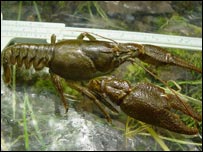Plight of the White-Clawed Crayfish
BBC
11 July 2006
James Lynn
In early autumn 1979 a prison break began. Under cover of darkness the escapee slipped past his captors and away into the chilly English night. Disorientated but determined, the north American signal crayfish scrabbled across the foreign terrain in search of fresh water.
Disorientated but determined, the north American signal crayfish scrabbled across the foreign terrain in search of fresh water.
The break-out was inevitable. Signals are fearsome among crayfish - stubborn and aggressive with large, versatile claws and a formidable climbing ability. The wire mesh covering the pond was bound to be conquered sooner or later.
During the 1980s, thousands of signals escaped trout farms in the south of England. At that time, white-clawed crayfish - the only species of freshwater crayfish native to the British Isles - thrived in the UK's waterways. Three decades later, they would be decimated.It is a common scenario. Since the signal arrived in the UK, hundreds of rivers have become infested with the fungus known to science as aphanomyces astaci, or more commonly, crayfish plague.
Despite its name, crayfish plague is harmless to the signal crayfish. Just as a mosquito is unaffected by the deadly malaria in its bloodstream, so the American species is immune from aphanomyces. Not so the white claw.
Dead Robin Found to Have West Nile Virus
mlive.com
11 July 2006
Jo Collins Mathis
Finding is the first one for Washtenaw County this season
A dead robin found in Ann Arbor has tested positive for the West Nile virus, becoming the first bird found with the virus in Washtenaw County for the 2006 West Nile season. The robin was found on June 27 in Ann Arbor's 48104 ZIP code.
"We've tested 11 birds already this year, and the robin is the first that's come up positive," said Laura Bauman, epidemiologist for Washtenaw County Public Health. "There's not a lot of virus circulating yet. The way it's worked in previous summers is that the virus accumulates in the ecosystem as we go through the summer, and it's not until we get to August and September that we start seeing human cases."
Still, she said, people should not wait to take precautions to avoid mosquitos, which spread the virus. In a prepared statement, Washtenaw County Medical Director Stan Reedy said: "The presence of a positive robin in Ann Arbor indicates active transmission of West Nile virus in our community. However, the level of intensity of transmission is probably still low."
Gorilla Susceptibility To Ebola Virus: The Cost Of Sociality
Cell Press (Posted by Science Daily)
10 July 2006
By monitoring a large population of gorillas during an Ebola outbreak in the rain forest of the Republic of the Congo, researchers have found that in a few months the virus exhibited dramatic--but disproportionate--impacts on group-dwelling and solitary gorillas. The findings offer a unique glimpse into the factors affecting the threat the deadly virus poses to great apes.
he work is reported in the July 12th issue of the journal Current Biology by a team of researchers including Damien Caillaud and colleagues from the University of Montpellier and the University of Rennes, France.
Ebola virus is extremely lethal for humans and other great apes. Since 1994, the Zaïre subtype of the Ebola filovirus has been responsible for nine human outbreaks in Gabon and the Republic of the Congo; a majority of these outbreaks have originated from the handling of infected great-ape carcasses. In fact, Ebola virus has become one of the major threats to the survival of western lowland gorillas (Gorilla gorilla gorilla) and chimpanzees (Pan troglodytes troglodytes) in this region.
However, the causes of outbreak among wild animals, and the way the virus spreads, remain unclear. It has been argued that the infection of apes only occurs by way of the so-called "reservoir" species (unknown, but possibly fruit bats), with ape-to-ape transmission playing only a minor role due to an insufficient rate of encounters between groups.
Migratory Birds Tested in Maine for Avian Flu
Associated Press (Posted by boston.com)
10 July 2006
BANGOR, Maine --Hundreds of Canada geese and other migratory birds are being captured and tested by Maine state biologists for avian flu.The testing of Canada geese, Arctic terns, common eiders and black guillemots by state Inland Fisheries and Wildlife biologists is being done to check for early signs of the bird flu virus before it channels over to Maine's commercial bird flock.
Biologists may end up testing hundreds if not thousands of birds before the program ends later this year.
Last week, biologists went to a pond near Rockport that's home to 80 to 100 Canada geese. The visit was timed to coincide with a period when the birds are molting, meaning most are unable to fly and are easier to capture.
Biologists in canoes corralled the geese toward a V-shaped pen set up at one end of Tolman Pond. Once the birds were removed to smaller cages, biologists collected fecal samples with long swab sticks.
Samples are sent to a lab in Connecticut for testing, and the results are sent to the U.S. Agriculture Department.





No comments:
Post a Comment